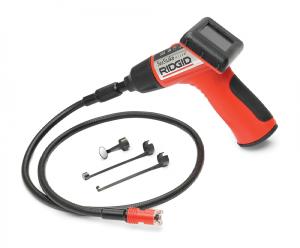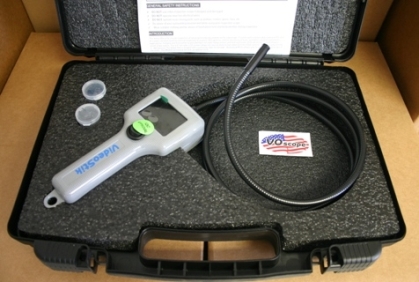Video Borescopes Under $400 – Comparison
September 6, 2008 10:10 am Auto Shop Tools, Tool ComparisonThe Rigid brand video inspection scope is called the SeeSnake
Fiber optic borescopes have been a great tool for auto techs, locksmiths, plumbers and electricians for years. Until recently there hasn’t been many options for a video based borescope that is affordable. Not too many auto technicians or electricians that want to spend five to ten thousand dollars for a fancy video based borescope. There are basically two options for a low priced video scope that can be used for a variety of purposes, the Rigid See Snake and the Visual Optics Video Stik.
Rigid Micro SeeSnake is an option with a 3 foot reach, a magnet and clip on mirror included. The main drawback with this tool is that the camera at the end of the wand is 0.70″ and that prevents the use of this tool in smaller areas like in an engine’s cylinder through a spark plug hole. A better size for the probe on borescopes and video endoscopes is under 0.50″ this allows access to much tighter areas. The Micro SeeSnake inspection camera has a 2.4″ color LCD screen that has 160 x 234 resolution.
The Visual Optics brand inspection scope is called the Video Stik
The Visual Optics video inspection tool is called the Video Stik, Visual Optics’ inspection scopes come in 36″ or 72″ and are made in the USA. The Video Stik with it’s 320x 240 pixel resolution, provides a more defined image compared to the Rigid SeeSnake with it’s 160 x 234 resolution. The camera on the end of the wand is smaller too. Compared to the Rigid brand that has 0.70″ diameter, the Video Stik has a 0.42″ diameter, allowing access to more spaces. The Visual Optics Video Stik also comes with accessories. The magnet an mirror are small enough to access very tight areas, after-all if they don’t fit into the area needed they are useless.
Automatic Focus allows for ease of use when compared to fiber optic borescopes. Fiberoptic bore scopes were at one time the only game in town when it came to affordable inspection scopes. New technology in affordable video based inspection scopes has changed this forever. New electronic gadgets like these, are sure to spawn more competition in the new Affordable Inspection Tool Arena, DLT’s top pick for automotive inspection is the Video Stik.


Ed McKiernan :
Date: September 6, 2008 @ 2:10 pm
RIDGID just launched a 0.37″ camera head with the SeeSnake micro in addition to the 0.7″ camera mentioned on this page. The 0.37″ camera head has no issues passing through spark plug bores.
dennisb :
Date: September 10, 2008 @ 6:47 am
Thanks Ed (VP of Marketing for RIGID) for your comments. At the time of this post there was no information on Rigid.com about the new size camera available on the SeeSnake. I appreciate you having Brian email me the pdf on the new design. The smaller size camera will allow more capabilities when it becomes available, for automotive use.
John Doe :
Date: November 11, 2008 @ 7:25 am
Looks good – why are the top end scopes so expensive?
dennisb :
Date: November 11, 2008 @ 7:41 am
Just like with cameras, the higher number of pixels, the more it costs. Also there are additional features that can drive the cost up. The good news is that the scopes in the blog are perfect for general use and are priced very low. The Visual Optics video scope even has an optional Video Grabber which allows the video footage to be transferred to a PC or laptop. After it is in a file on a computer it can be emailed to the client if desired or saved for future playback.
Henry :
Date: April 15, 2011 @ 12:58 am
I’m after something like the see snake or visual optics for my rifles which range from .22 diameter to .30 inch diameter. There is a huge market for these if you can still do this kind of price. The next closest appear to be the Hawkeyes up near the $1000 mark
John M :
Date: September 12, 2015 @ 12:27 pm
Just purchased the Time Sert 5600 from Wise Auto Tools to fix the inevitable Ford designed in Triton Spark plug problem. Did the Napa recommended “Sav-A-Thread thing” first, before checking with the experts to know what’s the “right” (and “wrong”) way to fix this. So the 5600 is my best option, at this point.
Really appreciated all the info you have made available to do the best job possible on this repair. Don’t have a video inspection tool though, and noticed on your video that you are using a rebranded Autel unit, and that this blog on that topic is quite a number of years old, so technology has probably improved since then.
Also, you offer a number of different models, brands, and price ranges for sale at Wise Auto/DenLors Tools.
Which is your current pick for all around mechanics use, and why?
Also, should/when I blow another plug in a hole that hasn’t had an insert before, does Time Sert recommend against using the Triple Oversized insert on the first time repair? And if so, why? (I will assume because it is the LAST option for insert bore size, so you have no chance to go bigger should it ever fail, which doesn’t seem to be much of a concern really…. but not using it on the first repair maintains one more option before head replacement).
I am aware of the 5678 kit to add to the 5600 in order to install the regular Big Sert only. A little spendy though if you aleady have the capability to just install the triple oversized insert.
Thanks.
John Meyer
dennisb - Auto Tool Sales :
Date: September 12, 2015 @ 2:20 pm
Hello John, thanks again for the purchase. Wow, this is an older blog for sure! The video cameras we most today are — 1. The Autel AULMV105 which uses a USB and connects to your laptop. And — 2. The stand alone one pn AULMV201-8.5 that has it’s own video screen (similar to what I used in the 5600 demonstration video). Here’s a link to all of our inspection cameras available today – video inspection cameras.
Unless your comfortable with technical stuff like making software and components work with your computer, which can be frustrating at times, I recommend the stand alone unit, because it’s pretty much “plug and play”.
As far as the 5600 kit being used on virgin holes as Time Sert says it… You are correct. Also the idea is to not remove anymore metal than necessary. I understand not wanting to buy the add-on kit though. Nothing would stop you from using the 5600 as long as you can get the reamer in to size the hole for tapping. In a shop setting it’s best to be capable of doing either repair. An individual owner can decide to go straight to the triple oversize after considering all options. Thanks and good luck. Let me know if I can assist any further.